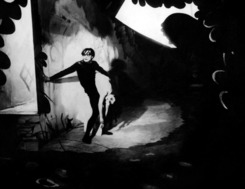Cinema's Brilliant Darkness: German Expressionist Film

Feb 07 - Feb 28, 2011
Four Mondays, February 7, 14, 21 & 28, 7–9pm
Instructor: Dickey Nesenger
Tuition: $100/WigglyWorld members, $120/general
Max Attendance: 25
Without German Expressionism, films by Alfred Hitchcock, John Huston, Orson Welles and Tim Burton might not have come into being. Their depictions of crime and horror amidst raw human emotions took root in Germany between World War I and World War II, when that nation's disintegrating psyche found a new voice and point of view through expressionist cinema, as depicted in such films as Lang's Metropolis, Wiene's The Cabinet of Dr.Caligari and F.W. Murnau's Nosferatu.
This four week study in Expressionist cinema is not a lecture course but hands on exploration into the history and impact of the movement on art and culture through a comprehensive viewing of films and in-class discussions that cover the form's guiding principles in cinematography and lighting, symbolism and theme, and character's human action of expressiveness. Films to be viewed in part or entirety include the abovementioned, plus additional scenes that exemplify what many film historians consider the greatest era of movies. In the final week we will examine contemporary films and filmmakers influenced by these earlier films.
You’ll be responsible for obtaining and watching the required films on your own. All of the films are available on DVD, and may be easily obtained for rental (we suggest Scarecrow Video), purchase, direct download, or on-demand viewing from Netflix, Amazon.com, Deep Discount DVD, Alibris, Powell’s, and other online resources. Be sure to obtain and watch the film far enough in advance that you will have seen it before our class on that film.
Register for Cinema's Brilliant Darkness
Learn more about German expressionism and art at Gage Academy
German Painting Between the Wars
Wednesday, 7:00pm-8:30pm 2/2-2/23
Richard West leads this thought-provoking investigation of post World War I painting in Germany. He starts with the unraveling of Expressionism in the aftermath of WWI, then explores the impact of Dada and Surrealism, the rise of a new realism (Neue Sachlichkeit), the art of the Bauhaus, and the fate of German painting in the early years of the Third Reich. Read more>